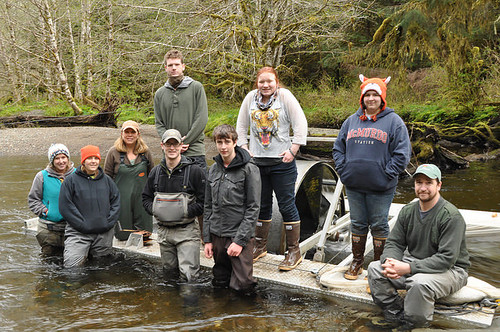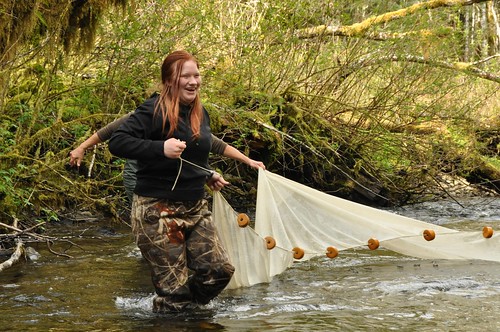
The Twelvemile Creek restoration monitoring crew and Fish Tech Boot Camp students and instructors pose for a photo in front of a screw trap, which captures coho and steelhead smolt that our migrating out to the ocean. The fish are released after being measured and marked with a coded wire tag. Students from Port Protection, Thorne Bay, and Klawock, Alaska, joined the crew composed of staff from the U.S. Forest Service, Sitka Conservation Society and the University of Alaska Southeast Fish Tech Program. Photo credit: Scott Harris, Sitka Conservation Society
This post was co-authored with Andrew Thoms, Executive Director of the Sitka Conservation Society.
“The thing that our forests grow best is salmon!” is the local phrase that a visitor is most likely to hear when visiting some of the 32 communities that live near the Tongass National Forest of Southeast Alaska.
Tongass National Forest staff, local school districts, a local conservation organization, and the University of Alaska have undertaken a joint project to figure out how a forest can be managed to create jobs and other economic opportunities and guarantee the long-term sustainable yield of the Tongass’ fisheries resources.
For thousands of years, the Tongass has been occupied by humans, supported by the bounty of salmon and other marine and forest resources of the Pacific coast. Today, salmon and fisheries continue to be the core of Southeast Alaska’s economy. Staff at the Tongass National Forest estimate that the Tongass produces over 25 percent of all salmon harvested in the Northeastern Pacific Ocean and is responsible for over $1 billion of economic activity a year. Given the historic and current cultural and economic importance of salmon, it is only logical that entities within the region are thinking about a salmon future.
“The Forest Service, the University of Alaska Southeast Fisheries Technologies Program, school districts on Prince of Wales Island and the Sitka Conservation Society came together to host the ‘fisheries technician boot camp,’” said Andrew Thoms, executive director of the Sitka Conservation Society. “Our goals were two-fold: first, we wanted to give youth on-the-job experience by working as part of a team monitoring salmon returns and spawning in a recently restored river. Second, we wanted to give students an idea of the jobs and careers available to them as land managers, essentially serving as stewards of the amazing salmon resource that the Tongass National Forest produces.”
In the program, students received hands-on training in fish capture, fish identification and tagging of juvenile salmon out-migrating to the ocean. Students received both college and high school credits for the experience.
Not only does the project collect valuable data for the Forest Service, but the students are also gaining a great deal.
Tamar Theurer, from Port Protection, Alaska, was one of the students selected for the program.
“I learned how to clip adipose fins and I learned how to identify different types of salmon and other fish,” Theurer said. “I learned more about the environment and habitats of fish and birds; and oh, I also learned my trees! Some of them at least. I want to go into fisheries, so not only will I have knowledge of how to do these things but I can also use this experience on my resume.”
This project is one of many collaborative efforts currently taking place on the Tongass National Forest and one of a wealth of programs to restore and protect wild Pacific salmon runs and fisheries stocks. Awareness is growing of the important role that National Forest System lands and watersheds play in producing wild Pacific salmon stocks. This program, and many others like it, will be integral to ensuring that salmon stocks continue to run thousands of years into the future.
The program received support from the National Forest Foundation.
This post is part of a series featuring the Forest Service’s work with partners on restoration across the country.

Tamar Theurer, from Port Protection, Alaska, learns how to set up a fyke net for monitoring fish abundance on the Tongass National Forest. Photo credit: Scott Harris, Sitka Conservation Society
No comments:
Post a Comment
Note: Only a member of this blog may post a comment.